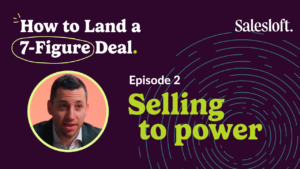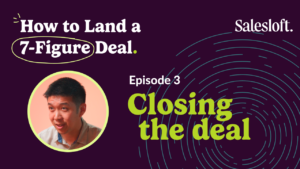In this three-part series, you’ll learn how a Salesloft AE lands multiple mega deals — from prospecting to selling to power, to delighting them as customers — so you can replicate his success.
In this first interview with Corey Goldstein, Salesloft’s Director of Product Marketing, Albert Rhee, asked how to get the most out of your enterprise plan of attack, new versus existing customers, sales and marketing alignment, and much more. Take notes. You’ll want to replicate these tactics with your own sellers, too.
This interview has been edited for clarity.
Albert:
What actually first interested you in the profession of sales?
Corey:
The easy answer is money. But, I would also say that coming out of college, I was not the best student. And the easiest job I could get out of college was sales. I was pretty good at it, and I’m still here about 10 years later.
Albert:
All right, so let’s talk about the topic at hand. What’s your entry point when you’re just getting started with one of these enterprise accounts? What’s your initial plan of attack?
Corey:
For me, the most valuable information is always going to be the people inside the organization. So I do what I call “bottoms up prospecting.” Luckily in sales, sellers have empathy for other sellers. So I try to actually find old Salesloft users or people who I feel have similar connections to me.
So, from there, I just go to someone internally who knows the ins and outs, who’s been there a couple of years. That has been my approach. And then I take whatever messaging that those people who are more day-to-day sellers or sales managers are using— bottoms up prospecting—and I use that message that they validated and bring it up to the executive level. That is typically where I start.
Albert:
So in the last 12 months, you’ve closed 7- figure deals on both new business, as well as expansions. Can you walk us through some of the similarities and differences in your approach to both of these types of accounts?
Corey:
Massively different, especially in a space like ours! So, from the net-new business perspective, that was really about credentialing myself, but also it was about showing examples of other companies that were similar to those new business clients, or maybe showing them some of their competitors that have used Salesloft and how those competitors are outpacing them. That way I really build that urgency and say, “What you shouldn’t do is test it out with a small group here or there. You should go big from the beginning.”
The existing customer is easier, I think. I can point to one of their business units or one of the regions that have used Salesloft and say, “Look at the success! We already have an existing agreement in place. Why don’t you scale it out and grow it a little bit more?” And if those customers have any questions, they can ask the people on their teams who are already using the product.
Albert:
So you’re working these accounts and you’ve got their attention. How do you use that attention to identify pain points in their organization that your product can solve?
Corey:
So that bottoms up prospecting? I will always use that throughout the entire cycle. But, I’ll also use that initial prospecting I did to understand the strategic initiatives of the company, the potential pitfalls, and the challenges that they’re having. Then I’ll tie back to those throughout my messaging.
As an example, if a potential customer is coming out with a new product or trying to grow revenue in a certain business unit, every level—especially the senior levels—should say, “This is actually going to help me solve a big goal.” It’s not just about making the client’s team a little more productive on a day-to-day basis.
Albert:
Can you talk a little bit about the sales and marketing alignment you create when you’re just getting started prospecting one of these accounts?
Corey:
Yeah, that’s where I would say a lot of the differences are between the new customer versus an existing customer. The existing customer knows us. And what I tried to do there was get their internal sellers at the existing customer’s company to echo the message of Salesloft.
One way is through RBEs — relationship building extras — which means sending customers swag. Here’s a perfect example: around this time last year, I knew that the key decision maker on one of my deals had two small kids. So I sent them a gingerbread house kit. No ask. Just here’s something from us. And now Salesloft has a positive association in their brain.
It helps that Salesloft does a great job of branding. Every time I showed up on site to do a training with an existing customer or meet with the executives, I would leave behind a pen, a mug, a notebook. Funny enough, the next time I showed up, that’s what they were drinking their coffee out of, or that’s what they were taking their notes out of. So it’s just constant reminders of Salesloft throughout their day. It’s something that some sellers might not think to do. Just take that little extra step.
And then at Salesloft, luckily we have a great marketing team that puts together great events. So I use LinkedIn to find out what prospects are close to those events, who might be able to make it, and then say, “Here’s why you should come to this event. Here’s the value for you.” It helps if you can offer those prospects a speaking part on stage to give them a little bit more visibility externally to build their brand.
Check out the rest of the series
Now that you have the basic tools for bottoms up prospecting, new versus existing customer tactics, and the positive power of relationship building extras, are you ready to learn even more? Check out part 2 and part 3 of the interview, and learn how to win over enterprise stakeholders and sell to power. Then subscribe to Salesloft on YouTube to get notified whenever we drop fresh sales advice.
 |
 |


